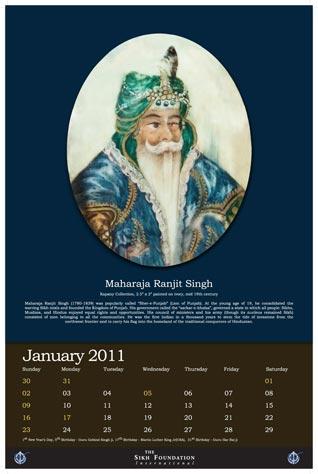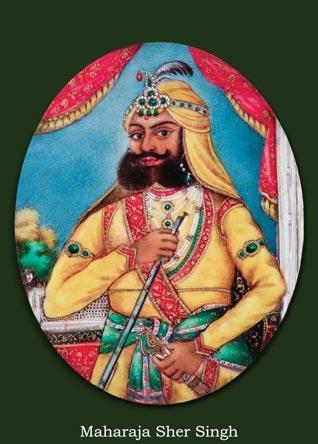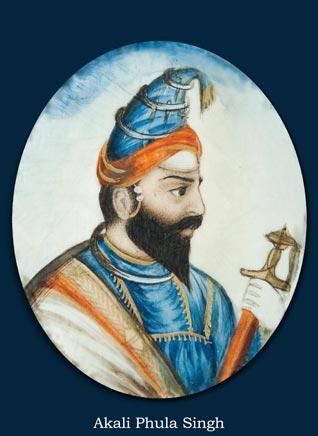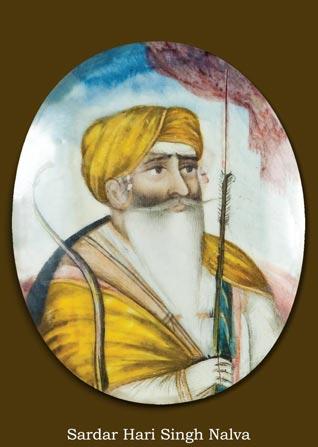Columnists
The Sikh Foundation Calendar 2011
by I.J. SINGH
Time flies, we know, and many are the ways that we have invented to keep track of its endless passage. Yet, as someone said, time and space are fragments of the infinite for the use of finite creatures that we are.
We need to track the endless march of time for only then can we connect the past to the present and these two to our hopes and dreams of a future. Calendars enable us to preserve the past. For tribal man, says Marshall McLuhan, space was the uncontrollable mystery; for technological man, it is time that occupies the same role.
Years come and go and we count them on a variety of calendars that, too, have changed and finally morphed into the one that we use to measure the passage of our lives. This Common Era calendar, usually designated by the initials CE, is not the only one but is the most widely used. The Muslims have their own, as do the Hindus and the Jews, to count only three. But many more exist, including a Sikh (Nanakshahi) calendar that dates from the birth of Guru Nanak, the founder of the faith.
The California based Sikh Foundation is now preparing and getting ready to release its newest calendar for the year 2011. It started the initiative of issuing a Sikh thematic Common Era calendar in the year 2000. The 2011 calendar gives us the dates of major historical events of Sikh history; its images focus on the Sikh Kingdom of Ranjit Singh & its courtiers.
Ranjit Singh's empire, as we know, had a relatively short, nearly fifty years old history, but its impact was and remains far more meaningful and longer lasting, even into this century.
Maharaja Ranjit Singh who founded it and led it most superbly was a young man of only 19 when he established it in 1799. He ruled it until he died in 1839. By all accounts, he was unusually ahead of his times and ruled a large swath of northwest India - from Kashmir, to the borders of Afghanistan - with compassion and justice that had not been seen in that part of the world for centuries. He ruled in the name of the Sikhs (Khalsa Raj) but it was not a partisan Sikh state that he created. He abolished the death penalty, and treated all subjects - Sikhs, Hindus and Muslims - with equal justice. He donated gifts and treasures to all places of worship equally - Hindu, Muslim and Sikh. He enjoyed and treasured the love of his people and rightly earned the sobriquet "Lion of Punjab." His senior officials came from all three religions extant in India at that time. Christians, too, though few in number, served in his government as senior generals in the army.
But at age 59, Ranjit Singh died, and within a few years the British swallowed up his extensive territories. Sikhs remember him as do the British who ruled his territories for a hundred years and the rest of India for twice as long. That Ranjit Singh's kingdom collapsed within a few years of his death I regard as an administrative failure of an otherwise great empire.
Ranjit Singh was fond of the arts and the finer things of life. His years of ascendancy have left us treasures for the ages. Particularly in the diaspora, the growing number of financially ascendant Sikhs are reclaiming relics and markers from Ranjit's Singh's defining era.
Narinder Singh Kapany, the founder of the Sikh Foundation has emerged as a leading collector of Sikh art of that time and has a keen eye for it. With an abiding interest in Sikh Art, the Sikh Foundation has established the Satinder Kaur Kapany Gallery of Sikh Art at the prestigious Asian Museum of San Francisco, the only such collection in North America. The Kapany Collection has also been exhibited at the Victoria and Albert Museum (London, England), the Royal Ontario Museum (Toronto, Canada), the Rubin Museum (New York), The Smithsonian (Washington, D.C.) and elsewhere.
The yearly calendar of Sikh Art is his brain child since 2000 and they have been exceptionally excellent. This year 2011 is no exception.
The 2011 calendar focuses on twelve (one for each month) significant personalities - the Maharaja himself and the courtiers who helped and served the Sikh Raj under him and his successors - each important in expanding his empire, administering his territories, and representing the public face of his governance. It highlights Ranjit Singh himself, and his son Sher Singh; Akali Phula Singh who was known for fearlessly telling the truth to authority; legendary generals like Sham Singh Attariwala and Hari Singh Nalva; Raja Tej Singh whom we remember for his duplicity during the British-Sikh wars; Hindus like Diwan Dina Nath and Diwan Mul Raj, Muslims like Fakir Aziz-Ud-Din, who was a physician and an outstanding diplomat; and even Sir Henry Lawrence who became the British Resident at Lahore in 1846 and died in battle during the Indian Mutiny of 1857.
All of the art work and portraits depicted in this calendar come from the Kapany Collection. The reproductions are excellent - collector items. The originals are 2 inch by 2 inch paintings on ivory. I suppose they are true miniatures. I wish we knew the exact medium used and perhaps some narrative on techniques and the artist(s), if any information is at all available. I doubt that they all come from the same artist. Exactly when do they seem to have been painted? Did the subjects sit for them or did the artist(s) work from sketches and existing material. Certainly, Ranjit Singh's painting seems to show an aging man somewhat past his prime.
Such information, even if limited, would have made the calendar more than that; it would then become a collectible and more of a lesson in Sikh history.
Highly recommended.
Readers can see images and additional information including how and where to purchase these calendars by logging on to www.sikhfoundation.org . Calendars are priced at $10.00 each (shipping and handling extra).
November 6, 2010
Conversation about this article
1: Kanwarjeet Singh (Franklin Park, New Jersey, U.S.A.), November 06, 2010, 11:18 AM.
The calendars from the Sikh Foundation are absolutely amazing. I happened to receive the 2010 Village Life of Punjab calendar last year and the quality of the pictures was simply amazing. Although I have been brought up in Bombay, I could feel my parent's excitement looking at the pictures and relating their childhood to the same. It also helps to educate people about your culture - I look forward to getting several copies of the 2011 calendar for my home and office. Another quality publication is the Nishaan magazine. The Sikh organizations such as SALDEF, Sikh Coalition, United Sikhs and even sikhchic.com should gift these calendars to everyone who makes a donation - it would help both the donating organization and the Sikh Foundation. Great work on the calendar - I am very excited about it.
2: Plate (U.S.A.), November 06, 2010, 12:11 PM.
I have bought calendars and paintings from the Sikh Foundation and I can say that they sell high quality items and I look forward to receiving my copy of this calendar. I wish the Sikh Foundation started selling stamps related to Sikh history and personalities. In India there are several such stamps in circulation and even Canada Post came out with a stamp on the occasion of the Tercentenary of the Khalsa. Stamps are an excellent way of recording history.
3: Sonia Kaur Dhami (Palo Alto, California, U.S.A.), November 08, 2010, 1:08 PM.
Thank you for your encouragement and support to the Sikh Foundation. Sikh Stamps are an inspiring way to emphasize history and we have made available Sikh stamps on our web-store in the past months. We will be having more soon. Please keep in touch.
4: Jasbir Singh Sethi (Houston,Texas, U.S.A.), November 08, 2010, 4:51 PM.
I sincerely admire Dr. I.J.Singh for such a wonderful article. I would like to add that there are calendars and calendars. I have seen numerous calendars produced for promoting businesses, of course bearing Sikh related pictures too. No doubt that Dr. Narinder Singh has given a completely new meaning to such a calendar. These are not just calendars, to keep track of days in a month. These depict timeless works of art. Each calendar gives you twelve beautiful works of art that can be framed and can turn your living room, office, lobby, etc., instantly into a mini Sikh art gallery. The first calendar that was produced in 2000 was based on the "Arts of the Sikh Kingdoms" Exhibition which started its journey the Victoria & Albert Museum in London, United Kingdom, stopped at the Asian Art Museum in San Francisco and then moved on to the Royal Ontario Museum in Toronto.






